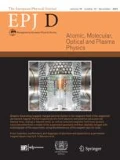Abstract:
Using a rigid-rotor model, we study the orientation dynamics of polar diatomic molecules excited by experimentally available half-cycle pulses. The results of the numerical solution of the time-dependent Schrödinger equation are compared to those of an approximate “sudden-impact” impulsive model neglecting the molecular rotation during the pulse. We show that efficient orientation is achieved during time periods of several picoseconds for LiCl. For short pulses, where the kicked molecule model is valid, orientation turns out to be mainly sensitive to the time-integrated field amplitude and not the shape or rise time of the pulse.
Similar content being viewed by others
Author information
Authors and Affiliations
Additional information
Received 16 August 2000 and Received in final form 4 December 2000
Rights and permissions
About this article
Cite this article
Dion, C., Keller, A. & Atabek, O. Orienting molecules using half-cycle pulses. Eur. Phys. J. D 14, 249–255 (2001). https://doi.org/10.1007/s100530170223
Issue Date:
DOI: https://doi.org/10.1007/s100530170223




